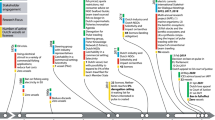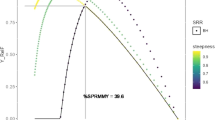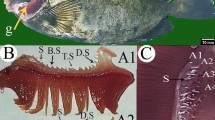Abstract
To evaluate a possible introduction of a new dredge in the fishery of Callista chione (Linnaeus, 1758), IPIMAR has conducted a study with the objective of comparing the efficiency of two dredges (traditional dredge and the new dredge design) and evaluating their impact on the benthic community. The experiments were carried out during March 1999 on the Southwest coast of Portugal, from a site off Troia. Three different tow durations of 5, 10 and 20 min were investigated. A total of 24 hauls were accomplished, 4 for each tow duration and dredge. The experiments were conducted by attaching a cover bag with a 20 mm mesh to the gear. After each haul, the catches in the bag and in the cover were sorted separately. All individuals retained were attributed scores on a scale of 1–4 in which 1 equates to good and 4 equates to dead. The results obtained showed that catches from the traditional dredge (TD) are composed of a great fraction of juveniles of C. chione, while in the new dredge (NDD) catches are composed, almost entirely, by individuals with a superior size to the minimum legal length (50 mm). This result indicates that the mesh of the bag of the TD used in the exploitation of this resource is not adequate. For the 3 different tow durations, the mean fishing yield obtained for the NDD was always superior to the TD, due to its greater efficiency in capture. The proportion of by-catch is significantly higher when the TD is used. For all 3 tow duration, the TD caused mortalities on the target species and on the macrobenthic community in the same order of magnitude as the NDD. Since the fishery of C. chione is managed by daily quotas per boat, when using the NDD the impact on the macrobenthic community is reduced by about 50% due to its greater efficiency of capture. Another advantage in the usage of the NDD relatively to the TD, is to allow the smallest individuals (independently of the species) to escape rapidly through the metallic bars on the grid, increasing their probability of survival.
Similar content being viewed by others
References
Arntz, W. E. & W. Weber, 1970. Cyprina islandica L. (mollusca, Bivalvia) als Nahrung von Dorschg und Kliesche in der Kieler Bucht. Ber Deut Wissen Komm Meeresforschung 21: 193–205
Bergman, M. J. N., M. Fonds, M. Hup, M. Lewis, P. Van der Puyl, A. Stam & D. Uyl, 1990. Direct effects of beamtrawl fishing on benthic fauna in the North Sea – a pilot study. In Effects of Beamtrawl Fishery on the Bottom Fauna of the North Sea. BEON-rapport 8: 33–57.
Bergman, M. J. N. & M. Hup, 1992. Direct effects of beamtrawling on macrofauna in a sandy sediment in the southern North Sea. ICES J. mar. Sci. 49: 5–11.
Bucqoy, E., P. Dautzenberg & G. Dollfus, 1882–1898. Les mollusques marins du Rousillon. Tome 2, Pelecypodes. J. Baillière & Fils, Paris: 884 pp.
Caddy, J. F., 1968. Underwater observations on scallop (Placopecten magellanicus L.) behaviour and drag efficiency. J. Fish. Res. B Can., 25: 2123–2124
DeAlteris, J., L. Skrobe & C. Lipsky, 1999. The significance of seabed disturbance by mobile fishnig gear relative to natural processes: a case study in Narraganset Bay, RI. In Benaka L. (ed.), Fish Habitat: Essential Fish Habitat and Rehabilitation. American Fisheries Society: 224–237.
Eleftheriou, A. & M. R. Robertson, 1992. The effects of experimental scallop dredging on the fauna and physical environment of a shallow sandy community. Neth. J. Sea Res. 30: 289–299.
FAO, 1987. Fiches FAO identification des especes pour les besoins de la peche. (Révision 1). Mediterranee et Mer Noire. Zone de peche 37. In: Fischer, W., M. Schneider & M.-L, Bauchot (eds), Vol I, Vegetaux et Invertebres. Rome, FAO: 371–512.
Fonds, M., 1994. Mortality of fish and invertebrates in beamtrawl catches and the survival changes of discards. In: Groot S. J. & H. J. Lindeboom (eds), Environmental Impact of Bottom Gears on Benthic Fauna in Relation to Natural Resources Management and Protection of the North Sea. NIOZ Report 1994-11, RIVODLO Report C026/94.
Gaspar, M. B., 1996. Bivalves do litoral oceânico algarvio. Aspectos da biologia, ecologia e da pescaria dos mananciais de interesse económico: aplicação à gestão dos recursos. PhD thesis, Universidade do Algarve, Faro.
Gaspar, M. B. & C. C. Monteiro, 1999. Indirect mortality caused to juveniles of Spisula solida due to deck exposure. J. mar. biol. Ass. UK, 79(3): 566–568
Gaspar, M. B., M. Castro & C. C. Monteiro, 1999. Effect of tooth spacing and mesh size on the catch of the Portuguese clam and razor clam dredge. ICES J. mar. Sci., 56: 103–110.
Gaspar, M. B., M. D. Dias & C. C. Monteiro, 1998a. A pescaria de bivalves do litoral oceânico da região de SetÚbal: situação actual dos principais bancos (Junho de 1997). Rel. Tec. Cient. IPIMAR, Lisboa: 12 p.
Gaspar, M. B., M. Castro & C. C. Monteiro, 1998b. The influence of tow duration and tooth length on the number of damaged razor clams, Ensis siliqua. Mar. Ecol. Prog. Ser. 169: 303–305.
Gruffydd, L. L., 1972. Mortality of scallops on a Manx scallop bed due to fishing. J mar. biol. Ass. U.K. 52: 449–445.
Kaiser, M. J. & B. E. Spencer, 1994. Fish scavenging behaviour in recently trawled areas. Mar. Ecol. Prog. Ser. 126: 31–38.
Kaiser, M. J. & B. E. Spencer, 1995. Survival of by-catch from a beam trawl. Mar. Ecol. Prog. Ser., 112: 41–49.
Kaiser, M. J. & B. E. Spencer, 1996. The effects of beam-trawl disturbance on infaunal communities in different habitats. J. anim. Ecol. 65: 348–358.
Kauwling, T. J. & G. J. Bakus, 1979. Effects of hydraulic clam harvesting in the Bering Sea. Tetra Tech. Report TC3324: 183 pp.
Lambert, J. & P. Goudreau, 1996. Performance of the New England hydraulic dredge for the harvest of Stimpson's surf clams (Mactromeris polynyma). Can. Ind. Rep. Fish. aquat. Sci. 235: 28 p.
McLoughlin, R. J., P. Young, R. Martin & J. Parslow, 1991. The Australian scallop dredge: estimates of catching efficiency and associated indirect fishing mortality. Fish Res. 11: 1–24.
Medcof, J. & N. Bourne, 1964. Causes of mortality of the sea scallop Placopecten magellanicus. Proc. Natl. Shell. Assoc. 53: 33–50.
Medcof, J. & J. F. Caddy, 1971. Underwater observations on performance of clam dredges of three types. ICES C.M. 1971/B:10.
Meyer, T. L., R. A. Cooper & K. J. Pecci, 1981. The performance and environmental effects of a hydraulic clam dredge. Mar. Fish. Rev. 43(9): 14–22.
Michael, K. P., G. P. Olsen, B. T. Hvid & H. J. Cranfield, 1990. Design and performance of two hydraulic subtidal clam dredges in the New Zealand. New Zealand Fis. Tech. Rep. 21: 16 p.
Naidu, K. S., 1988. Estimating mortality rates in the Iceland scallop, Chlamys islandica (O.F. Muller). J. Shell. Res. 7: 61–71.
Poppe, G.T. & Y. Goto, 1993. European Seashells. Vol II (Scaphopoda, Bivalvia e Cephalopoda). Verlag Christa Hemmen, Germany: 221 pp.
Ramsay, K. & M. J. Kaiser, 1998. Demersal fishing disturbance increases predation risk for whelks (Buccinum undatum L.). J. Sea. Res. 39: 299–304
Sokal, R. R. & F. J. Rolhf, 1981. Biometry. 2nd edn. W.H. Freeman & Company. New York: 859 pp.
Tebble, N., 1966. British Bivalve Seashells. A Handbook for Identification. British Museum. Edinburgh: 212 pp.
Watling, L. & A. Norse, 1998. Disturbance of the seabed by mobile fishing gear: a comparison with forest clear-cutting. Cons. Biology 12(6).
Zar, J. H., 1996. Biostatistical analysis. 3rd edn. Prentice-Hall, Inc. USA: 662 pp.
Author information
Authors and Affiliations
Rights and permissions
About this article
Cite this article
Gaspar, M.B., Dias, M.D., Campos, A. et al. The influence of dredge design on the catch of Callista chione (Linnaeus, 1758). Hydrobiologia 465, 153–167 (2001). https://doi.org/10.1023/A:1014587212528
Issue Date:
DOI: https://doi.org/10.1023/A:1014587212528
- dredge
- fishery impact
- Callista chione
- mortality
- by-catch
- Pharus legumen
- Ensis ensis
- Solen marginatus
- Ensis siliqua
- Mactra glauca
- Lutraria anguistor
- Echinocardium cordatum
- Laevicardium crassum
- Spisula solida
- Venus striatula
- Dosinia exoleta
- Dosinia lupinus
- Acanthocardia tuberculata
- Cymbium olla
- Gibbula sp.
- Nassarius reticulatus
- Astropecten aranciacus
- Pagurus sp.
- Polybius henslowi
- Calappa granulata




